8 popular moisture meters put to the test
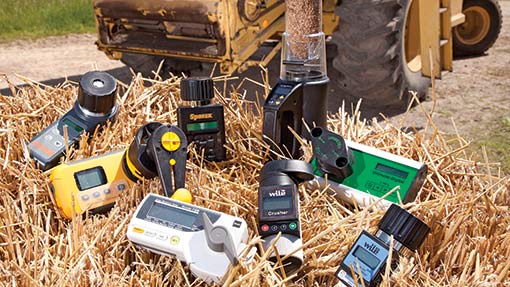
Trading in the old moisture meter for a slicker new model won’t have been at the top of many farmers’ to-do lists at harvest.
Let’s face it, giving the combine’s wheezing air-con a bit of attention or getting those chunky flotation tyres for the trailers will be a lot more pressing.
But buying a decent tool to help you cut at the right time and only dry as much as you have to will have a considerably more exciting impact on your back pocket.
Tap a search into Google and you’ll be flooded with options from £250 to well over a grand. But which should you go for? Grinding? Whole-grain? Cheap? Expensive?
We’ve done the hard work for you by getting our hands on eight of the most common ones.
See also: Dorset grower’s guide to building a cash-saving DIY grain dryer
How we tested them
Step one was to give each moisture meter a thorough going-over on farm.
Working our way through a bucket full of wheat gave a good indication of how easy they were to live with and showed us just how variable the readings can be between machines.
The next step was to do what most farmers say they do on their annual Assured Combinable Crops Scheme (ACCS) form – take them to a moisture meter clinic.
We picked a session hosted by Dengie Grain near Maldon, Essex, which was run by grain testing aficionado Jo Cauvain of Tendring Lab Services.
Straight out of the box they were put to work on Jo’s certified samples. These included hard wheat, soft wheat, conventional oilseed rape, hybrid oilseed rape and peas, all with varying moisture contents.
Some meters were way off the mark and others weren’t too bad. But once we’d made a couple of adjustments they were all giving satisfactory results.
Two machines did stand out in the out-of-the-box accuracy test, though – Martin Lishman’s Protimeter and the Unimeter Digital.
These are both calibrated in the UK and the Unimeter Digital even comes with a certificate to show that it has been calibrated by Openfield.
This did make a difference as both returned pretty consistent readings straight off. The Protimeter was the most accurate on cereals and oilseeds, but it was a tad wayward on the peas.
Some churned out readings as low as 12.8% for a 15.3% wheat sample, while others said peas at 16.7% moisture were as high as 18.8%.
After calibration they were all giving satisfactory readings, so it definitely pays to get them checked over every now and again – even if you’ve got a brand new model.
Grinding moisture meters
The following four meters crush or grind and compress the sample before taking a reading. This means they tend to give more consistent results than whole-grain meters as the moisture content is constant throughout the sample.
The downside it that they’re more of a faff to use and there’s a bigger margin for operator error.
Wile 78 The Crusher
Best for Easy grinding
Made by Farmcomp OY, Finland
Sampler type Integrated grinding head
Sample size 9ml
Manufacturer’s claimed accuracy +/- 0.5%
Crops it can test Twenty-three pre-programmed crops as well as an arbitrary scale
Additional features Calculates sample averages
Moisture measurement range Grains: 9-38%, Oilseeds: 5-30%
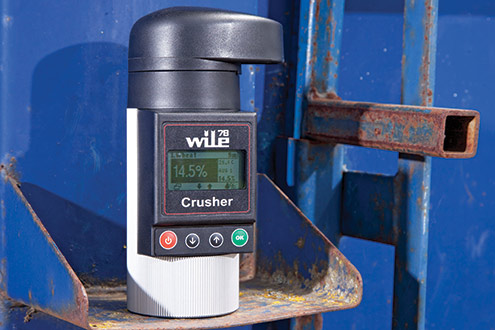
Ease of use The Wile 78 was the simplest grinding moisture meter to use by some margin.
Samples are measured into the crusher using the built-in scoop and you grind and crush the grains by screwing the lid down.
The grinder mechanism is similar to the one on the Unimeter Digital, but it’s much easier to turn and there’s an obvious stop position. The backlit screen is easy to use, too, and it’s quick to deliver a reading.
Carrycase It comes with a tough, padded fabric case that has a shoulder strap. There’s also space inside the case to fit a Wile 65 whole-grain meter.
Calibration process Individual crop calibrations are easy to tweak, but well enough hidden to stop unwanted adjustments.
Battery 1 x 9V
From APM
Price £365 plus VAT
Verdict The Wile 78 was our favourite grinding meter to use. The crushing head was almost as easy to turn as a whole grain meter and it didn’t need any extra paraphernalia for measuring out samples. It was also neat to carry around and the backlit screen was easy to see.
Picking gunky oilseed rape out of the grinding teeth was less pleasant, though, and it didn’t seem to grind the sample as fine as some others.
We didn’t think the grinding mechanism was as strong as the Unimeter either, and we did have to makes some adjustments to the calibration.
Likes
✔ Clear backlit display
✔ Scoop built into lid and easy to grind
✔ Simple to use
Gripes
✘Not as fine a grind as the Unimeter or Martin Lishman
✘The grinding mechanism doesn’t look as strong as the one on the Unimeter Digital
✘Needed some adjustments to the calibration
Unimeter Digital
Best for value
Made by Farmcomp Oy, Finland
Sampler type Grinding
Sample size 9ml or 11ml
Manufacturer’s claimed accuracy +/- 0.5%, but Openfield calibrates them to +/-0.3%.
Crops it can test Thirty-one pre-programmed crops and an arbitrary scale
Additional features Calculates sample averages
Moisture measurement range Grains: 10.4-39%, Oilseeds: 5.4-25%
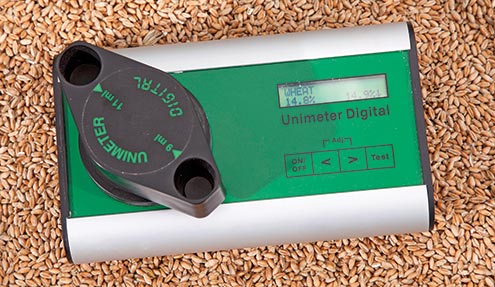
Ease of use The grinding mechanism isn’t for the limp wristed – after putting 20 samples through we were flagging. It’s also not obvious how far you have to wind it in so reading the instructions is a must. These are pretty clear though. The screen is also easy to use.
Carrycase Hard plastic case.
Calibration process Calibration is simple, but you’ll need to glance at the instructions.
From Agricultural Supply Services
Battery 1 x 9v
Price £345 plus VAT
Verdict If you’ve got a lot of samples to work through you’ll get a bit fed up with the grinding head on the Unimeter.
According to UK importer Agricultural Supply Services a lot of farmers fashion a lever to help get a bit more purchase on it.
The plus side is that this gives a finer grind helping it to be one of the most accurate straight out of the box. It also comes set up and calibrated for UK crops.
The electronics are basic and easy to use, too, and the sample measuring scoops are incorporated into the grinding head. It’s also pretty reasonably priced.
Likes
✔ Gives consistent readings on most crops
✔ Electronics are easy to use
✔ Every model is calibrated by Openfield before it’s delivered
Gripes
✘Very difficult to grind sample
✘No backlight on display
✘Hard to know when sample is ground enough
Protimeter Grainmaster i-S
Best for accuracy
Made by Martin Lishman, Taunton, England
Sampler type Grinding, with detachable grinder and compressor unit
Sample size 10ml
Manufacturer’s claimed accuracy +/- 0.5%
Crops it can test Fifteen pre-programmed crops, a 0-100 scale and 30 reference calibrations
Additional features Optional external moisture and temperature probes. Spares packages available
Moisture measurement range Wheat: 11.3-29.3%, OSR: 7-26%, Barley: 10.9-29.3%
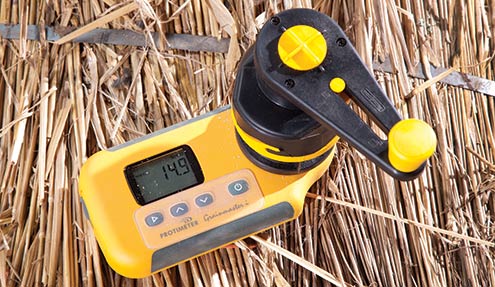
Ease of use The grinder and compressor unit is a bit of a fiddle and you need to read the instructions to make sure you’re using it properly. Once mastered it’s easy to grind and obvious when the sample has been milled enough.
You need a 10ml spoon to get the correct sample size, which is too easy to lose. The box itself is easy to use.
Carrycase Hard plastic carrycase.
Calibration process It’s easy to add in calibration adjustments for each crop (if you’ve read the instructions) and there’s a warning to tell you they’re active. You need to watch that you don’t adjust them by mistake, though.
From Martin Lishman
Battery 1 x 9V and spare in case
Price £526 plus VAT including a free service
Verdict The Protimeter is probably the most common moisture meter in the UK and it was a solid performer in our tests.
Sample prep isn’t the most straightforward, but when it’s new it’s easier to grind than some others.
Blades do wear out, though, and if you don’t replace them it’s a pig to turn and doesn’t mill the sample properly.
There is a spare set in the case and extras cost £26 plus VAT. The rest of the unit is easy to use and returned some of the best results in out out-of-the-box accuracy test. It’s not the cheapest though.
Likes
✔ Consistent readings on grains and oilseeds
✔ Obvious when the sample is ground
✔ Easy to replace wearing parts
Gripes
✘Grinding and compressing is a bit of a performance compared with some others
✘Blades wear out
✘Separate plastic sample spoon and Wile Crusher
✘Easy to adjust calibrations when you don’t mean to
Riceter F508
Best for clear screen
Made by Kett, Japan
Sampler type Crushes a small number of grains with a screw head
Sample size Very small – roughly 14 grains of wheat
Manufacturer’s claimed accuracy +/- 0.5%
Crops it can test Twelve pre-programmed crops and no arbitrary scale
Additional features Averages can be calculated for up to nine test readings, after which it resets. These are also only remembered for five minutes
Moisture measurement range Cereals: 9-30%, Oilseeds: 6-22%
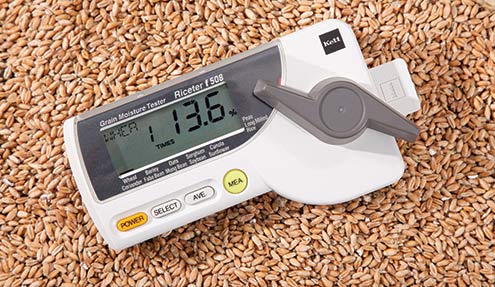
Ease of use The screen is easy to navigate and it’s quick to get a test result.
The small sample means less time needed to rub out grains, but this won’t be as representative as a bigger one.
The tiny sample trays are also a fiddle and are too easy to lose. In the instructions it says peas and beans have to be crushed with pliers before they are loaded into the sampling chamber.
However, importer Farm-Tec says a single pea or bean can be loaded whole.
Carry case Small hard plastic case that houses all components.
Calibration process It’s possible to calibrate the meter for different crops, but it’s definitely one to do with the instruction book close by.
From Farm-Tec
Battery 4 x AA
Price £295 plus VAT
Verdict We mentioned the Riceter to a few people in the know and it didn’t get the most glowing reviews. But we quite liked it.
The display was the clearest on test and the small sample size means you don’t have to spend hours rubbing out samples.
Accuracy didn’t seem to be a problem on well-conditioned grain, but you’d probably need to average a few tests at harvest. There are also a few too many bits and pieces to go missing.
Likes
✔ The clearest screen on test
✔ Easy to crush and compress sample
✔ Quick to give a result
Gripes
✘Having to slide in small sample trays that are easy to lose
✘Tiny sample size won’t be as representative as some others
✘Difficult to alter crop calibrations
Whole-grain moisture meters
Whole-grain meters simply compress the grain sample in order to get a reading. So no tough and tedious grinding and no mess to clear up at the end.
They work well with conditioned grain, but are not so consistent at harvest time when moisture content varies. This means you should always take an average.
Wile 65
Best for ease of use
Made by Farmcomp Oy, Finland
Sampler type Compressing head
Sample size 65ml
Manufacturer’s claimed accuracy +/- 0.5%
Crops it can test Sixteen pre-programmed crops and an arbitrary scale
Additional features Calculates test averages. Optional temperature probe
Moisture measurement range Grains: 8-35%, Oilseeds: 5-25%
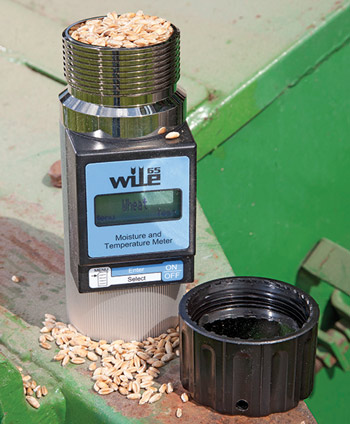
Ease of use Simple. Just scoop crop into the chamber and level off. Then turn lid until metal disc becomes flush with top of lid.
This requires little effort. Just two buttons to flick through to choose crop type and carry out the test.
Carrycase Thin plastic box.
Calibration process Calibrations for each crop are quick and easy to adjust. The problem is that they’re easy to erase too.
From APM
Price £335 plus VAT
Verdict The canister-style metal body is small, easy to hold and feels tough enough to carry around without the case.
The compressing head is well made, too, and it didn’t get bunged up with grains. The screen is a bit old-school and could do with a couple more buttons though.
Some readings were a bit erratic, but the average was pretty good in conditioned grain.
Likes
✔ Really easy to use
✔ Handy size
✔ Good build quality
Gripes
✘ Slightly old-school display
✘ No backlight on screen
✘ Easy to adjust calibrations by mistake
Mini Gac Plus
Best for extra features
Made by Dickey-John, Illinois, USA
Sample type Whole-grain meter without compressor
Sample size Big
Manufacturer’s claimed accuracy +/- 0.5%
Crops it can test Nine crops are stored on the machine out of the box, but there are more than 450 different calibrations that can be loaded in from the PC software.
Additional featureS Averages of up to 20 samples are stored on the machine and the data can be downloaded to a computer. It also calculates specific weight.
Moisture measurement range Wheat: 8-34%, Barley: 8-29%, OSR: 6-21%
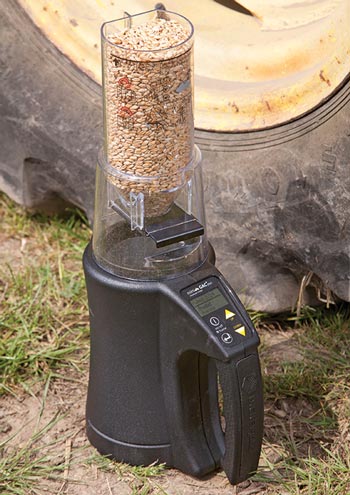
Ease of use The Mini Gac is pretty easy to fathom, but it is a bit of a faff to use. Before every reading you have to carry out an empty cell test to make sure it’s zeroed.
The jug also has to be level or it won’t work. There’s no grinding to be done, but you need a big sample to fill it.
Carrycase Padded canvas; tough and well made.
Calibration process This can be adjusted via the keypad on the machine.
From Farm-Tec
Battery 1 x 9V
Price £620 plus VAT; for more modest budgets, try Dickey-John’s £450-plus-VAT Mini Gac that calculates moisture content only.
Verdict With its specific weight calculation and mountain of extra features, the Mini Gac plus is in a slightly different league to the other whole-grain meters on test.
If you’re willing to take the time, you could probably get a lot out of it, but we found it a bit tedious when taking readings on the fly.
The large sample size also means it isn’t suitable for rub-outs. We think it’s one to keep at the grain store and have another more portable meter to take to the field.
Likes
✔ Neat for a higher-end device
✔ Gives a hectolitre weight reading
✔ Screen easy to read and navigate
Gripes
✘Size of sample
✘Having to carry out empty cell tests before each reading
✘Takes time to get the most from it
Agripro 6095
Best for handy size
Made by Sinar, England
Sampler type Compressing head
Sample size 65ml
Manufacturer’s claimed accuracy +/- 0.5%
Crops it can test Nineteen pre-programmed crops and an arbitrary scale
Additional features Works out test average and displays to the right of current test reading
Moisture measurement range 5-45% moisture range
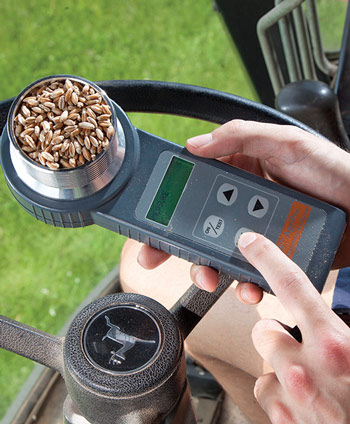
Ease of use The Agripro’s compressor was harder to turn than other similar models and we found it a bit too easy to cross thread.
Grains also tended to get stuck inside the compressing cap. On the plus side it’s neat, lightweight and the screen is easy to fathom.
Carrycase Hard plastic case.
Calibration process Calibrations are simple to adjust without reaching for the instructions.
From Evans and Pearce
Battery 1 x 9V
Price £459 plus VAT
Verdict For a premium-priced product, the Agripro fell a little short. The electronics were simple and easy to use, but we felt the compressor wasn’t as well made as some others.
It only took a few seconds to load the sample, but we then spent time fishing grains out of the compressor mechanism.
It’s neat to carry around, though, and the buttons and screen also look like they’ll keep the dust at bay.
Sinar also makes a grinding version called the Farmpro, which has a similar mechanism to the Wile Crusher and Unimeter.
Likes
✔ Handy size
✔ Simple to use
✔ Dust-busting buttons
Gripes
✘Grains get stuck up side of compressor unit
✘Expensive compared with other similar meters
✘Easy to cross-thread the cap
MT-Pro
Best for tight budgets
Made by Agratronix, USA
Sampler type Compressing head
Sample size 65ml
Manufacturer’s claimed accuracy +/- 0.5%
Crops it can test Forty-nine pre-programmed crops
Additional features Backlit display
Moisture measurement range Different for all crops but white wheat moisture only goes up to 22%
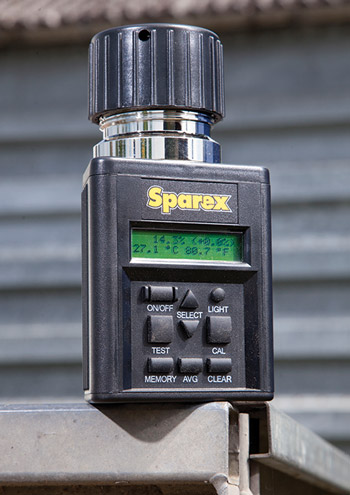
Ease of use Straightforward to use with a sample cell that’s almost identical to the Agripro and Wile 65. It’s quick to get a reading, but the large list of crops on the display is tedious to scroll through. Crop types are US-focused and it isn’t obvious which settings to use in the UK.
Carrycase Wraparound canvas case designed to stay on the meter when in use.
Calibration process Crop calibrations can be adjusted in the screen, but it’s not that easy and the instructions are poor.
Price £246 inc VAT
Verdict The MT-Pro was the cheapest meter on test by some margin and it did feel a bit more flimsy than the competition.
That said, the compressing head was almost identical to the more expensive Wile 65. There are plenty of buttons, but they don’t make the tricky menus any easier to navigate.
You’ll see it with lots of different branding. Ours came from BRM, but had Sparex stickers on it.
Likes
✔ Easy to fill sample
✔ Lightweight
✔ Big rubbery buttons
Gripes
✘Confusing menus
✘ Feels cheap
✘ Two 9V batteries needed – the others take one
Moisture meter dos and don’ts
Whether your moisture meter’s shiny and new or a tad careworn there are a few important steps you can take to get more accurate results. Grain testing expert Jo Cauvain runs through the basics.
Do:
- Check your meter out at a moisture meter clinic or against test samples annually
- Learn how to use it properly – I see lots of people using their meters incorrectly, which means they never return accurate results
- Make sure all residues are removed before testing new samples – this is particularly important with some grinding meters that get residues stuck in their teeth
- Use the sample measuring spoon or scoop to fill your moisture meter – different-sized samples give different results and the meter has been calibrated for one particular size
- Take two or more readings and calculate an average – this is particularly important for whole-grain meters that tend to give less consistent readings
- Use a 0.5% safety margin.
Don’t:
- Keep your moisture meter in an air-conditioned combine cab or in direct sunlight as it needs to be at roughly the same temperature as the crop – for the most accurate readings the meter and sample should both be about 20C
- Load your moisture meter with a dirty sample – any chaff in the sample will cause the meter to read about 0.5% lower than it should
- Handle the sample too much – dirty, sweaty palms will skew the readings
- Keep using a damaged of heavily worn meter – worn-out grinders are a particularly common occurrence and will give inaccurate readings as well as being a pain to use
- Use your meter while holding or perched on uneven surfaces – they are most accurate on a firm, level base.
Editor’s note: These prices are correct at time of writing this article

